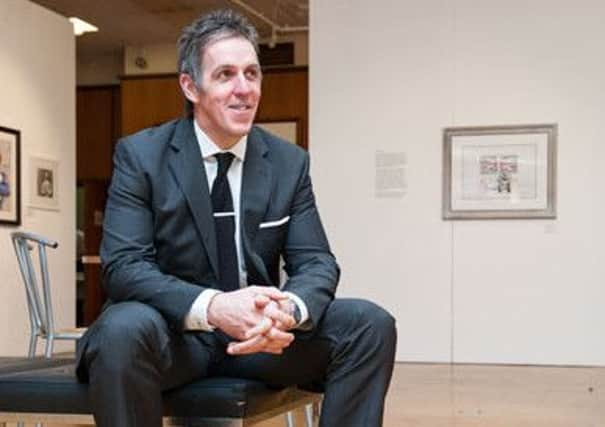Behind mask of faceless creator


Best known for his trademark character Mr Faceless, Lee Coleman’s latest exhibition at Doncaster Museum and Art Gallery is a fascinating one man show that displays a thought-provoking series of images shown alongside objects that inspire his art – including his Vespa scooter and his first guitar.
But the Scunthorpe-based artist also earns his living as a full-time paramedic – and it was after a traumatic event on the job that he came up with the idea of Mr Faceless.
Advertisement
Hide AdAdvertisement
Hide Ad“I had to give a lady the unfortunate news one day that I couldn’t revive her husband – and obviously that news is very devastating. It’s a powerful emotion that people go through when dealing with a loss like that,” Lee, 41, explains. “I wondered if I could get that level of emotion onto a sheet of paper without showing a facial expression – could you express it with body language and location?
“And that’s where the idea of Mr Faceless came in. I came home and started doodling, and asked myself if I could do it – if I could start using emotional settings and scenarios. It’s amazing that something so unfortunate for a patient has blossomed into something visual. Mr Faceless is part of me really.”
Although Lee was not formally trained at an art college or university, he honed his craft for over 20 years by producing caricatures for family and friends. He grew tired of this, and gave up on drawing until he felt that he had something meaningful to say. “If you have a passion for something artistic, whether it’s cooking, music, art, or whatever it is, you eventually evolve and grow and start to challenge yourself – it’s been more organic than anything,” Lee explains.
Once he opened himself up to dealing with emotional subjects and drawing on his working life, Lee became more than a caricaturist – he became an artist. “Being a paramedic, we see such an array of colourful characters and scenarios that you can’t help but absorb it really. As an artist, a lot of your work ends up being autobiographical because it’s part of your soul. A lot of the things I experience can sneak their way in without you really knowing it sometimes.”
Advertisement
Hide AdAdvertisement
Hide AdLee explained that having an outlet for expression has been necessary for dealing with difficulties he faces on a day-to-day basis. “Like any job, you have good and bad days, but my bad day is unfortunately that somebody might have lost their life in quite a traumatic way – and that does affect you. So when you come home, it’s good to be able to channel that energy – I don’t drink, I don’t smoke – I play guitar, or I produce artwork.
“It’s definitely therapeutic – it’s an emotionally lifting experience when you produce artworks out of something that’s quite awful.” Lee has worked for East Midlands Ambulance Service for over a decade. He has been a state registered paramedic for almost seven years and has no intention of giving up the day job to become a full-time artist. “It’s the best job in the world – it’s very challenging and very rewarding, it can break your heart but it can make you smile.”
When asked about how he wants his audience to respond to his work, Lee said: “I want people to go away and think about what they’ve seen. I really want people to be affected by it. I want it to stop people in their tracks and think ‘bloomin’ heck, that really makes me think’. That’s all that matters to me.”
Lee Coleman: Six is at Doncaster Museum and Art Gallery until June 22.
Visit: www.leecoleman.co.uk
Portrait of the artist as medic
Advertisement
Hide AdAdvertisement
Hide AdFor the past year, Lee Coleman has been followed around by documentary film-makers.
The film, which is currently being edited, follows Lee in his life as a paramedic and an artist.
Lee says: “They came out with me in my ambulance and filmed me coming out of work with blue lights and sirens going, and then watched me work in the studio.”
The film culminates on the opening afternoon of the Doncaster exhibition, and brings to a close an exhibition that was a year and a half in the making.
Lee described it as a “long hard slog”.